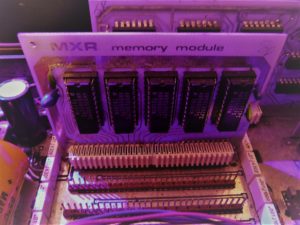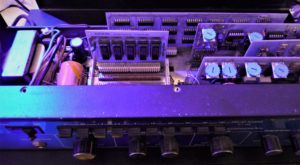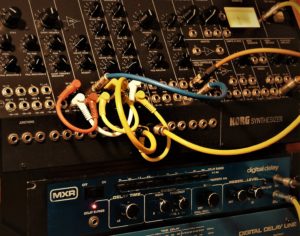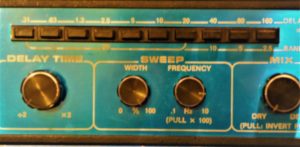The MXR M-113 Digital Delay has been one of the most popular first generation audio delays, as it had a good quality but was more affordable than the previous processors. Introduced in ’76 at around 1000 USD, it was still expensive, but a lot less than the other digital delays available in the market.
MXR was specialized in guitar pedals, this delay was instead offered in a 19″ rack unit and, same as the other effects of the professional rack series, (Flanger/Doubler, Graphic EQ, Pitch Transposer) became very popular and used by famous artists such as David Gilmour, Frank Zappa, Roger Waters, Brian May and Mike Rutherford.
Modular

To contain costs, a modular architecture was chosen. Optional memory boards were inserted in slots, to increase the delay time, but these were pretty expensive, costing almost like a complete unit.

Digital noise..well not only that! :D
Unfortunately the M-113 Digital Delay, same as its collegues of the same period, is pretty noisy and not only referring to the actual standards. Apart digital noises always present, these processors have a marcated tendency to generate audio hum.
The Model 113, Digital Delay has a maximum bandwidth of 20KHz, but this decreases with longer delays, down to 2.5KHz. The longer the time between repetitions, the tighter the passing frequency band, being reduced through antialiasing filters (HPF and LPF) the more the delay time is increased.
MXR Digital Delay Test Drive
As there a re several video examples already of this delay tested on guitar, I thought it could have been a good idea to try it, using some unusual but hopefully interesting sounds.
re several video examples already of this delay tested on guitar, I thought it could have been a good idea to try it, using some unusual but hopefully interesting sounds.
To record, I used a dbx DI box and the signal sent to a Universal Audio 610 tube preamp, even taking all possible counter-measures, still a bit of hum is audible.
On the examples below, I feeded as sound source, a sweep from the filters in feedback of an old Korg MS-50 synthesizer, some piano chords I had recorded from a real piano and a couple of seconds of an oldschool reggae classic.
MXR Digital Delay, Test-01, (MS-50 Filter Sweep)
01) Dry sound, straight from the MS-50.
02) Delay Range 160ms, Delay Time x2, 50% mix and maximum regen (feedback)
03) Delay Range 160ms, Delay Time 0, 50% mix and maximum regen (feedback)
04) Delay Range 160ms, Delay Time 1/2, 50% mix and maximum regen (feedback)
05) Delay Range 160ms, Delay Time Sweep 01 (moving the Delay Time knob)
06) Delay Range 160ms, Delay Time Sweep 02 (moving the Delay Time knob)
MXR Digital Delay, Test-02 (Piano)
I chose these piano chords I recorded as, having long decays, are ideal to test the effect of short repetitions, when modulated. The effects space from phasing to complete madness. The last one is a strong modulation at the higher band of frequency of the sweep, reminding the effect of a ring modulation.
1) Dry Piano
2) Delay Range 1.3ms, 50% mix
3) Delay Range 10ms, 50% mix
4) Delay Range 160ms, 50% + Mod
5) Max Frequency Mod
MXR Digital Delay, Test-03 (Rhythmic Loop)
 On the following examples, let’s try something that really impressed me first time I played with a Powertran (An article on it, is coming soon). On the MXR the feedback has a faster decay and there’s not the “freeze” function, but the effect it is interesting, too. Once the delay is at tempo with a rhythmic pattern, having adjusted the decay time knob, all Delay Range buttons create a different version of the pattern, but on different speeds. Being the buttons based on a double time sequence, all these are compatible in tempo. Let’s experiment with a small classic reggae riddim loop:
On the following examples, let’s try something that really impressed me first time I played with a Powertran (An article on it, is coming soon). On the MXR the feedback has a faster decay and there’s not the “freeze” function, but the effect it is interesting, too. Once the delay is at tempo with a rhythmic pattern, having adjusted the decay time knob, all Delay Range buttons create a different version of the pattern, but on different speeds. Being the buttons based on a double time sequence, all these are compatible in tempo. Let’s experiment with a small classic reggae riddim loop:
1) Dry loop
2) Loop effected as sort of Beat Repeater
MXR Digital Delay, Test-04 (MS-50 patch)
Last example, this time using a more complex sound from the MS-50.
1) Dry MS-50 sound
2) MXR MS – 50%MIX, 75% Feedback
3) MXR MS – 50%MIX, 75% Feedback + Mod
4) MXR MS – 50%MIX, 75% Feedback + Fast Mod
Service Manual: https://app.box.com/s/4t78o8xtzd

